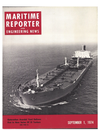
Page 4: of Maritime Reporter Magazine (September 1974)
Read this page in Pdf, Flash or Html5 edition of September 1974 Maritime Reporter Magazine
The Sydhav, shown on trials, is the first ship to be built by Gotaverken using the shipyard's new facilities.
Gotaverken Arendal Yard Delivers
First In New Series Of 32 Tankers
The first vessel in a series of 32 tankers of 140,000 to 154,000 dwt, the Sydhav, which are on order with Gotaverken Arendal, Goth- enburg, Sweden, was delivered recently. The
Sydhav also is the first ship to be equipped with a Burmeister & Wain K90 engine, built by Gotaverken under the license agreement of 1972.
Including the Sydhav, Gotaverken has built no less than 200 tankers in Gothenburg.
The first one was the motor tanker Hamlet, 7,210 dwt, which was delivered in 1916 and at that time attracted attention for its speed, size and design. On this ship Gotav- erken introduced the system of two longi- tudinal bulkheads which then became stand- ard in tankers.
The Sydhav has been built to the highest class of Det norske Veritas and bears the class EO (unmanned machinery room) and the special notation "Inert." It is 885 feet 10 inches in length overall and 883 feet 0% inches between perpendiculars. The beam is 142 feet 0% inches and has a depth of 73 feet 7% inches and a summer freeboard draft of 56 feet. The deadweight is 140,800 tons and the registered gross tonnage is 74,100.
The total cargo-oil capacity at 98 percent full is 6,005,740 cubic feet, in the four cen- ter tanks and 12 side tanks. Clean-water bal- last can be carried in the fore and aft peak tanks and in two side tanks. The total clean- water ballast capacity is 573,505 cubic feet.
The hull design has many features com- mon to tankers but also a number of less orthodox structural arrangements. The web spacing in the cargo tanks is 201 inches, in the after peak and counter 23.6 inches, in the engine and pump room 35.5 inches, and in the forepeak area 33.5 inches. High ten- sile steel was used almost exclusively for the longitudinal hull plating and profiles and also in parts of the transverse bulkheads and deep web frames. Forty-five percent of the total hull steel consists of such high- tensile steel, almost all of which was pro- duced in Swedish mills.
Primary structural stiffness of the longi- tudinal panels is afforded by the transverse bulkheads and by the deep transverse web frames. This has made possible the omis- sion of the centerline deck girder. The cen- terline bottom girder has a height much lower than the bottom transverse and serves as a docking girder only. The transverse bulkheads have horizontal stiffeners and deep, vertical web frames.
All crew staterooms are on the second deck or higher. Only storerooms are located on the upper deck. Messrooms, dayrooms, galley, etc. are on the first poop deck. "Float- ing floors," consisting of a wooden board resting on mineral wool with no battens to the steel deck give good soundproofing and vibration reducing effect. All bulkheads and ceilings are of incombustible material.
The ship has single-berth cabins with showers and water closets for officers and single-berth cabins with semi-private shower and water closet for the crew. The accom- modations, including the wheelhouse, are fully air conditioned by a high-pressure single-pipe system and cabin ventilators with individual electric preheating facilities.
The main engine is an eight cylinder, two- stroke, crosshead, large-bore diesel engine.
This engine retains some of Burmeister &
Wain's traditional design features, such as single-stage impulse turbo-charging, uniflow scavenging with top-mounted central ex- haust valve, oil-cooled pistons, etc. Another feature is the completely new design of the frame. This is a very stiff construction, con- sisting of a few, horizontally joined elements instead of the previous vertically subdivided cylinder units. The exhaust valves are hy- draulically operated. The cylinder covers are of solid steel plate with radial cooling-water bores in the upper part and tangential in the lower part. Hydraulically tightened nuts are used extensively.
The machinery is normally controlled from a sound-insulated, air conditioned control room. Arrangements are made for at least 24-hours operation in the unmanned condi- tion.
The three auxiliary diesel engines are 12- cylinder, V-type units made by Bergens Mek.
Verksted, each coupled to one 1,100-kw
Nebb air-cooled alternator. Two of the alter- nators can be disconnected from the engine by a pneumatically operated clutch. By means of this clutch, the diesel can be en- gaged to a bevel gear driving a cargo pump through a vertical shaft system. When driv- ing the pumps the cargo-pump speed can be controlled from the pump room, from which also the coupling can be disengaged.
During normal operation at sea, the steam for all heaters in the engine room, bunker heating and domestic heating is produced in a Gotaverken/Sunrod exhaust-gas boiler.
Steam for cargo heating, the two turbine- driven cargo pumps and the deck machinery is produced in two oil-fired Gotaverken/
Sunrod boilers, each with a capacity of 20 tons of saturated steam per hour.
Because of the system with two diesel- driven and two turbine-driven cargo pumps, an optimized and simple steam plant has been possible and an ample supply of inert gas is available at the same time.
Sludge oil produced by the machinery is burnt in a Saxlund incinerator which also can handle garbage. A Neptumatic sewage plant also is installed.
Several new investments at the shipyard have been utilized to their fullest in build- ing the Sydhav and in this respect this ship marks the beginning of a new era at Gotav- erken Arendal.
The Family Cabin on the Sydhav has a unique arrangement combining the sleeping and lounge areas in one space. 60 Maritime Reporter/ Engineering News

 3
3

 5
5
